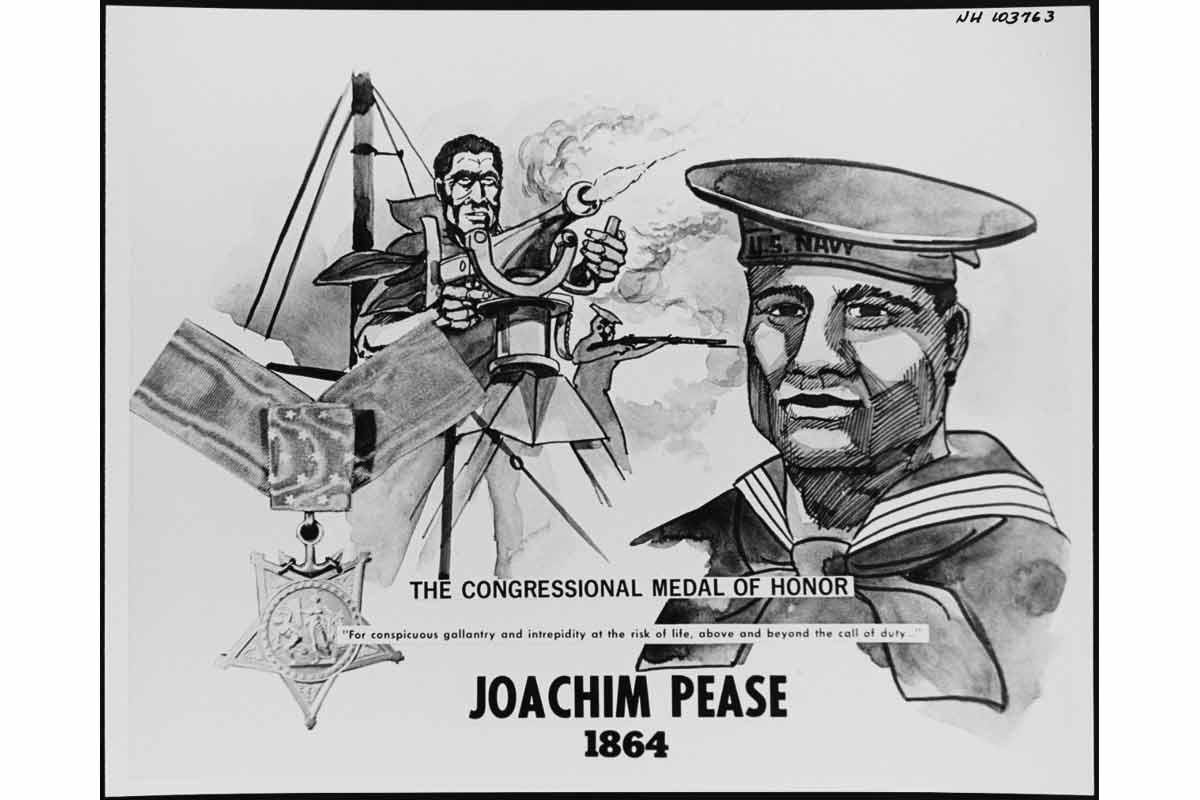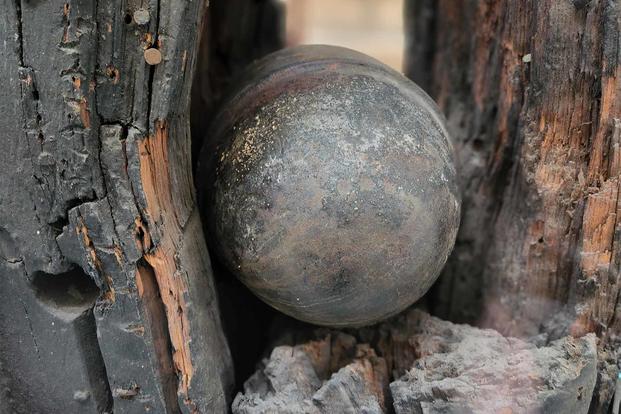
The aristocrats from Paris went down to Cherbourg, France, by special train to join the crowd lining the shore and cheering on the Confederate commerce raider Alabama in an epic duel at sea with the Union sloop of war USS Kearsarge on June 19, 1864.
A French warship, the Couronne, with a band on deck playing “Dixie,” accompanied the Alabama to the three-mile territorial limit off Cherbourg. The waiting Kearsarge turned away from the coast to bring the Alabama further out into international waters, and then turned again to fight.
At his post aboard the Kearsarge was Ordinary Seaman Joachim Pease, from the Cape Verde islands off Africa’s west coast. He was a loader on one of the Kearsarge’s big deck guns that sent the Alabama to the bottom after a one-sided battle of about 65 minutes.
Read Next: Here’s How the Army Is Keeping Basic Trainees from Getting Injured as Often
For his actions during what came to be known as the Battle of Cherbourg, Pease would be awarded the Medal of Honor.
The inscription engraved on the back of his medal reads: “Personal Valor/Joachim Pease/(Colored Seaman)/ U.S.S. Kearsarge/Destruction of the Alabama/June 9, 1864,” but the date is wrong — the battle was fought on June 19.
The date mix-up, possibly the fault of the engraver, was one of several mistakes or oversights the Navy made in seeking to record who Pease was, where he was from, how he came to enlist, and what happened to him when he left the service.
Black Sailors in the Civil War
Pease was one of eight Black sailors awarded the Medal of Honor from among about 18,000 Black sailors who served the Union during the Civil War, according to Navy records, but he never received the medal.
“The Navy just couldn’t find him” after the war to give him the medal, said historian John Quarstein, director emeritus of the USS Monitor Center at the Mariners’ Museum and Park in Newport News, Virginia.
Military records at the time were filled with inaccuracies, and “many sailors when they joined used an alias. Some of these people just disappeared” when their service was done, Quarstein, who has written on the contributions of Black Civil War sailors, told Military.com
Most of the Black sailors held the rank of “landsman,” the lowest rank in the Navy at the time, which was given to those with little or no experience at sea, Quarstein said.
Some were former slaves or escaped slaves. Some were free Blacks living in the North. Others were listed as “contrabands,” or slaves who had been taken into custody as Union forces pressed South. They served in all of the major battles at sea that contributed to the Union victory.
Landsmen Wilson Brown, a former slave from Natchez, Mississippi, and John Lawson, a free Black from Philadelphia, were with then-Rear Adm. David Farragut aboard his flagship, the Hartford, in the Aug. 5, 1864, Battle of Mobile Bay when Farragut was said to have shouted “Damn the torpedoes [mines] … full speed ahead!”
Both Brown and Lawson were assigned below decks to operate a device called the “shellwhip,” which was used to lift boxes of gunpowder to the main deck.
Brown was knocked unconscious “when an enemy shellburst fatally wounded a man in the ladder above,” his medal citation said. Then Brown “upon regaining consciousness, promptly returned to the shellwhip on the berth deck and zealously continued to perform his duties although 4 of the 6 men at this station had been either killed or wounded by the enemy’s terrific fire.”
Lawson was “wounded in the leg and thrown violently against the side of the ship when an enemy shell whipped on the berth deck,” his citation said. “Lawson, upon regaining his composure, promptly returned to his station and, although urged to go below for treatment, steadfastly continued his duties throughout the remainder of the action.”
The other five Black sailors who received the Medal of Honor fighting for the Union were Landsman Aaron Anderson; Ordinary Seaman Robert Blake; Landsman William H. Brown; Signal Quartermaster Thomas English: and Engineer’s Cook James Mifflin.
Black sailors also played a role in the Battle of Hampton Roads on March 8 and 9, 1862, when the fearsome ironclad CSS Virginia, which was built on the scuttled hull of the Union steam frigate Merrimack, faced off with the USS Monitor and its revolutionary rotating gun turret on the second day of the engagement.
On the first day, the Virginia came to break the Union blockade and ravaged the defenders, destroying the sloop USS Cumberland and the frigate USS Congress while training withering fire on the frigate USS Minnesota, which had run aground but continued to fight.
The Virginia withdrew as night approached and returned the next day to finish off the Minnesota, but there was the Monitor, whose odd design was described in the South as that “Yankee cheesebox on a raft.” The Monitor and Virginia fought to a virtual draw, but the Minnesota was saved.
Capt. Gershom Jacques Henry Van Brunt, commander of the Minnesota, would later write in praise of the all-Black crew of 16 sailors who served the aft pivot gun, and speculated on why they remained steadfast against the onslaught of the Virginia.
“The [men] fought energetically and bravely — none more so,” Van Brunt wrote. “They evidently felt that they were thus working out the deliverance of their race.”
President Abraham Lincoln signed the bill creating the Medal of Honor in December 1861 for sailors and Marines who distinguished themselves by “their gallantry in action and other seaman-like qualities during the present war.” The Medal of Honor was authorized for the Army the following year.
Of the more than 3,500 Medals of Honor awarded to date, more than 1,500 were awarded for actions in the Civil War, the most for any period in American history. A total of 26 Civil War Medals of Honor were awarded to Black service members in the Civil War — 18 in the Army and eight for naval personnel.
The Union Army and Navy entered the war with entirely different rules and regulations on the service of Black men. The Army officially banned service by Blacks until the ban was lifted on Jan. 1, 1863, when Lincoln issued the Emancipation Proclamation.
The Navy had never barred Blacks from serving, although beginning in the 1840s, their numbers were limited to 5% of the enlisted ranks, said Joseph Reidy, professor emeritus at Howard University and director of the university’s African-American Sailors Project.
Before the war ended, about 180,000 Black soldiers had served in the Army, but shoddy guesswork by the Navy initially put the number of Black sailors at about 29,000, Reidy said in an interview with Military.com and in a 2001 article for the National Archives’ Prologue Magazine.
But a fuller examination of the records by Howard University, the Navy, and the National Park Service put the number of Black sailors in the Civil War at about 18,000 who served with the belief, sometimes stated and sometimes unspoken, that “the outcome of the war would be the end of slavery,” Reidy said.

So Who Was Joachim Pease?
One of the 18,000 who stood out was Joachim Pease, by reason of his rank as Ordinary Seaman, which marked him as an experienced sailor, and also by his actions in the battle with the Alabama.
“He was a bit exceptional in that sense too,” and likely would have been “one of the most respected men on the ship,” Reidy said.
Still, the mystery remains on why he never received his medal and what happened to him after the war.
“He just totally disappeared,” and researchers have never been able to find a trace of his family or possible descendants, Reidy said.
Even his Medal of Honor citation had one and possibly two mistakes in stating the reasons for the award, said Wesley Schwenk, a former curator and now the registrar at the National Museum of the United States Navy at the Washington Navy Yard.
The citation reads: “PEASE, JOACHIM, Seaman, USN. Born Long Island, N.Y.,” and then goes on to state that he “served as seaman on board the U.S.S. Kearsarge when she destroyed the Alabama off Cherbourg, France, 19 June 1864. Acting as loader on the No. 2 gun during this bitter engagement, PEASE exhibited marked coolness and good conduct and was highly recommended by his divisional officer for gallantry under fire.”
But the Navy has since concluded that he was from Fogo Island in Cape Verde, rather than Long Island, and that he most likely served in the risky task of loading the No. 1 gun, a 32-pounder, and not the No. 2 gun, Schwenk said in an interview at the Museum and in follow-up emails.
Other mistakes in the original records complicated the Navy’s efforts to find Pease after the war, according to a 2020 article posted by the Naval History and Heritage Command (NHHC).
The enlistment records for New Bedford, Massachusetts, showed that Pease joined the Navy in January 1862 with the rank of Ordinary Seaman and listed his birthplace as “Togo Island,” which does not exist.
But further analysis of the handwritten enlistment record showed that the “T” in Togo Island was really an “F,” meaning Fogo Island. At first, that was taken to mean Fogo Island in Newfoundland, but the Navy eventually settled on Fogo Island in Cape Verde.
Cape Verde was a common stop for New England whaling ships to resupply and pick up crew, and the records of the New Bedford Whaling Museum show that a “Joakim Pease” was listed in the ship’s log of the whaler Kensington on the ship’s 1857-1861 voyage, NHHC said.
In an email statement to Military.com last week, the embassy of Cape Verde in Washington, D.C., said there was no record of a Joachim Pease in the country’s databases.
Although the Navy never found Pease, his imagined likeness was featured on one of the baseball-type cards of naval heroes the Navy commissioned in 1962 from the Topps trading card company.
His medal was transferred from storage at the Bureau of Medals to the Naval History and Heritage Command in 1957, and it was on display until recently at the National Museum of the United States Navy near an artifact of the Kearsarge-Alabama battle.
The artifact still on display is of the remnants of the rudder post of the Kearsarge, with a football-sized unexploded shell fired by the Alabama embedded in it. Some historians have maintained that if the dud had gone off, the Alabama might have won, but Schwenk said the Kearsarge still would have prevailed.
As for the Pease medal, Schwenk said in an email, “At the current time there are no plans to return it to display, but it may be used in other upcoming exhibits currently being planned by the exhibits team here at the National Museum of the United States Navy.”
— Richard Sisk can be reached at [email protected].
© Copyright 2022 Military.com. All rights reserved. This material may not be published, broadcast, rewritten or redistributed.
